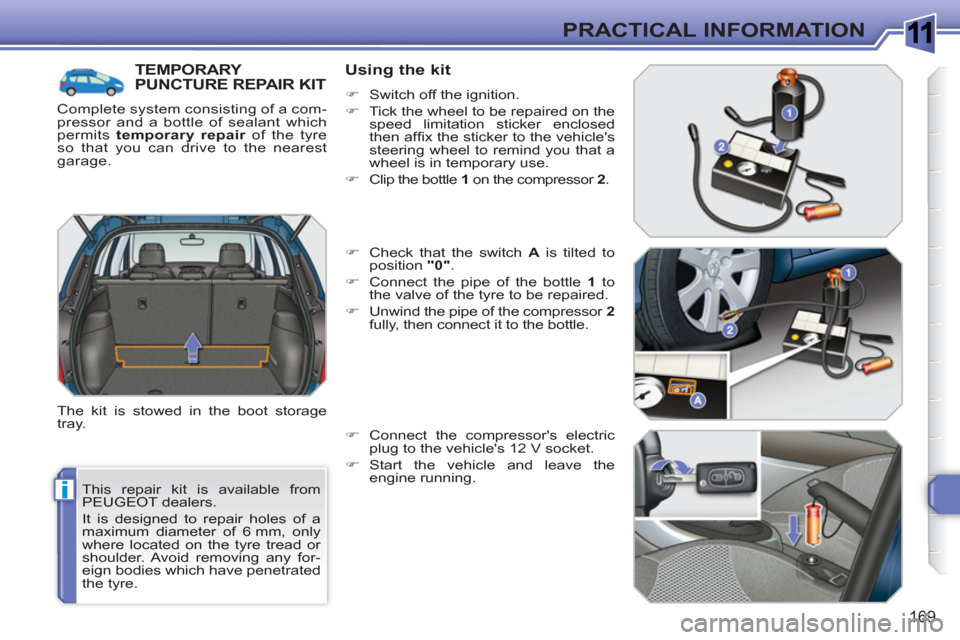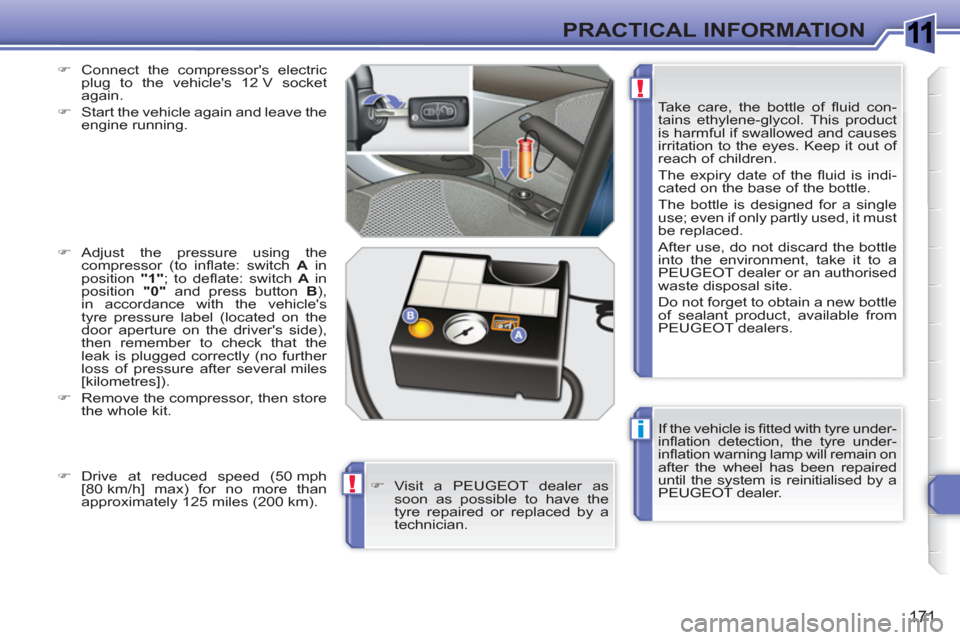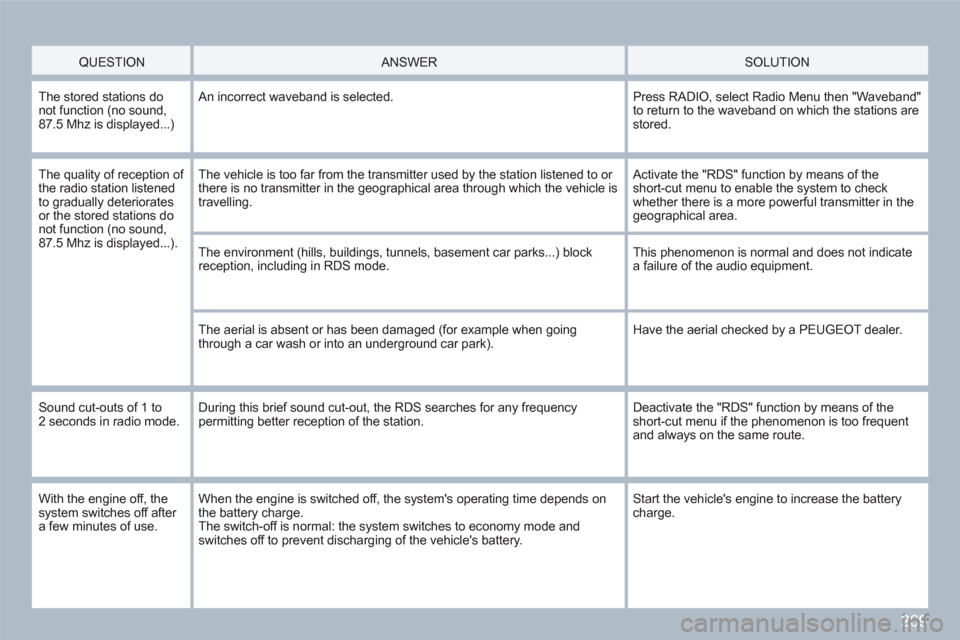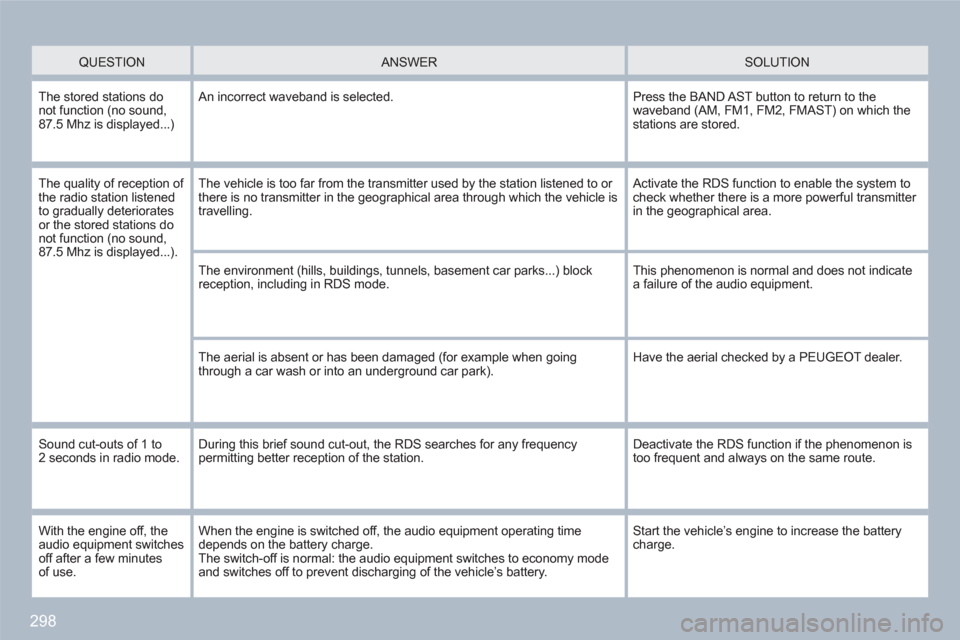2011 Peugeot 308 SW BL check engine
[x] Cancel search: check enginePage 170 of 336

1
!
168
PRACTICAL INFORMATION
Beware of discharges of fl uid.
The expiry date of the fl uid is indi-
cated on the cartridge
The sealant cartridge is designed
for single use; even if only partly
used, it must be replaced.
After use, do not discard the car-
tridge into the environment, take
it to an authorised waste disposal
site or a PEUGEOT dealer.
Do not forget to obtain a new
sealant cartridge, available from
PEUGEOT dealers.
Removing the cartridge
�)
Stow the black pipe.
�)
Detach the angled base from the
white pipe.
�)
Support the compressor vertically.
�)
Unscrew the cartridge from the bottom.
Checking tyre pressures/
inflating accessories
You can also use the compressor, with-
out injecting any product, to:
- check or adjust the pressure of your
tyres,
- infl ate other accessories.
�)
Turn the selector A
to the
"Air" position.
�)
Uncoil the black pipe H
fully.
�)
Connect the black pipe to the valve
of the wheel or accessory.
If necessary, fi t one of the adaptors
supplied with the kit fi rst.
�)
Connect the compressor's electrical
connector to the vehicle's 12 V
socket.
�)
Start the vehicle and let the engine
run.
�)
Adjust the pressure using the
compressor (to infl ate: switch B
in
position "I"
; to defl ate: switch B
in
position "O"
and press button C
),
according to the vehicle's tyre pressure
label or the accessory's pressure
label.
�)
Remove the kit then stow it.
Page 171 of 336

1
i
169
PRACTICAL INFORMATION
This repair kit is available from
PEUGEOT dealers.
It is designed to repair holes of a
maximum diameter of 6 mm, only
where located on the tyre tread or
shoulder. Avoid removing any for-
eign bodies which have penetrated
the tyre.
TEMPORARY PUNCTURE REPAIR KIT
Complete system consisting of a com-
pressor and a bottle of sealant which
permits temporary repair
of the tyre
so that you can drive to the nearest
garage.
The kit is stowed in the boot storage
tray.
Using the kit
�)
Switch off the ignition.
�)
Tick the wheel to be repaired on the
speed limitation sticker enclosed
then affi x the sticker to the vehicle's
steering wheel to remind you that a
wheel is in temporary use.
�)
Clip the bottle 1
on the compressor 2
.
�)
Check that the switch A
is tilted to
position "0"
.
�)
Connect the pipe of the bottle 1
to
the valve of the tyre to be repaired.
�)
Unwind the pipe of the compressor 2
fully, then connect it to the bottle.
�)
Connect the compressor's electric
plug to the vehicle's 12 V socket.
�)
Start the vehicle and leave the
engine running.
Page 173 of 336

1
i
!
!
171
PRACTICAL INFORMATION
If the vehicle is fi tted with tyre under-
infl ation detection, the tyre under-
infl ation warning lamp will remain on
after the wheel has been repaired
until the system is reinitialised by a
PEUGEOT dealer. Take care, the bottle of fl uid con-
tains ethylene-glycol. This product
is harmful if swallowed and causes
irritation to the eyes. Keep it out of
reach of children.
The expiry date of the fl uid is indi-
cated on the base of the bottle.
The bottle is designed for a single
use; even if only partly used, it must
be replaced.
After use, do not discard the bottle
into the environment, take it to a
PEUGEOT dealer or an authorised
waste disposal site.
Do not forget to obtain a new bottle
of sealant product, available from
PEUGEOT dealers.
�)
Connect the compressor's electric
plug to the vehicle's 12 V socket
again.
�)
Start the vehicle again and leave the
engine running.
�)
Adjust the pressure using the
compressor (to infl ate: switch A
in
position "1"
; to defl ate: switch A
in
position "0"
and press button B
),
in accordance with the vehicle's
tyre pressure label (located on the
door aperture on the driver's side),
then remember to check that the
leak is plugged correctly (no further
loss of pressure after several miles
[kilometres]).
�)
Remove the compressor, then store
the whole kit.
�)
Visit a PEUGEOT dealer as
soon as possible to have the
tyre repaired or replaced by a
technician.
�)
Drive at reduced speed (50 mph
[80 km/h] max) for no more than
approximately 125 miles (200 km).
Page 195 of 336

1
!
i
193
PRACTICAL INFORMATION
Do not disconnect the terminals
while the engine is running.
Do not charge the batteries without
disconnecting the terminals fi rst.
Do not push the vehicle to start the
engine if it is fi tted with a 6-speed
electronic gear control gearbox.
The batteries contain harmful sub-
stances such as sulphuric acid and
lead. They must be disposed of in
accordance with regulations and
must not, in any circumstances, be
discarded with household waste.
Take used remote control batteries
and vehicle batteries to a special
collection point.
It is advisable to disconnect the
battery if the vehicle is to be left un-
used for more than one month.
Before disconnecting the battery
Wait 2 minutes after switching off
the ignition before disconnecting
the battery.
Close the windows and the doors
before disconnecting the battery.
Following reconnection of the
battery
Following reconnection of the bat-
tery, switch on the ignition and wait
1 minute before starting to permit
initialisation of the electronic sys-
tems. However, if problems are en-
countered following this operation,
contact a PEUGEOT dealer.
Referring to the corresponding sec-
tion, you must yourself reinitialise:
- the remote control key,
- the panoramic sunroof blind,
- the GPS satellite navigation
system.
Charging the battery using a
battery charger
�)
Disconnect the battery from the
vehicle.
�)
Follow the instructions for use
provided by the manufacturer of the
charger.
�)
Reconnect starting with the negative
terminal (-).
�)
Check that the terminals and connectors
are clean. If they are covered with
sulphate (whitish or greenish deposit),
remove them and clean them.
�)
Connect one end of the green
or black cable to the negative
terminal (-) of the slave battery B
.
�)
Connect the other end of the green
or black cable to the earth point C
on the broken down vehicle.
�)
Operate the starter, let the engine
run.
�)
Wait until the engine returns to idle
and disconnect the cables.
Page 199 of 336

1
i
i
!
197
PRACTICAL INFORMATION
TOWING A TRAILER, A CARAVAN, ETC.
Your vehicle is primarily designed for
transporting people and luggage, but it
may also be used for towing a trailer.
Driving advice
As the fan is electrically controlled, its
cooling capacity is not dependent on
the engine speed.
�)
To lower the engine speed, reduce
your speed.
The maximum towing load on a long
slope depends on the gradient and the
ambient temperature.
In all cases, pay attention to the coolant
temperature.
Side wind
�)
Take into account the increased
sensitivity to side wind.
Cooling
Towing a trailer on a slope increases
the temperature of the coolant.
Braking
Towing a trailer increases the braking
distance.
Tyres
�)
Check the tyre pressures of the towing
vehicle and of the trailer, observing the
recommended pressures.
Lighting
�)
Check the electrical lighting and
signalling on the trailer.
The rear parking sensors will be de-
activated automatically if a genuine
PEUGEOT towbar is used.
�)
If the warning lamp and the
STOP
warning lamp come
on, stop the vehicle and
switch off the engine as
soon as possible.
Towbar suitable for the attachment of a
trailer or caravan with additional lighting
and signalling.
Distribution of loads
�)
Distribute the load in the trailer so
that the heaviest items are as close
as possible to the axle and the nose
weight approaches the maximum
permitted without exceeding it.
Air density decreases with altitude, thus
reducing engine performance. Above
1 000 metres, the maximum towing load
must be reduced by 10 % and so on for
every 1 000 metres of altitude.
Refer to the "Technical Data" section for
details of the weights and towing loads
which apply to your vehicle. Driving with a trailer subjects the towing
vehicle to more signifi cant stress and its
driver must be particularly careful.
We recommend the use of genuine
PEUGEOT towbars and their har-
nesses that have been tested and
approved from the design stage
of your vehicle, and that the fi t-
ting of the towbar is entrusted to a
PEUGEOT dealer.
If the trailer is not fi tted by a
PEUGEOT dealer, it is imperative
that it is fi tted using the electrical
pre-equipment installed at the rear
of the vehicle, in accordance with
the manufacturer's instructions.
If your vehicle is fi tted with the
1.6 THP 200 hp engine, you can-
not fi t a towbar. The space occu-
pied by the sport exhaust system
prevents this.
Page 229 of 336

1
i
227
TECHNICAL DATA
IDENTIFICATION MARKINGS
Various visible markings for the identifi -
cation and tracking of your vehicle.
If the tyre pressures are too low,
this increases fuel consumption.
The tyre pressures must be
checked when the tyres are cold,
at least once a month.
A.
Vehicle Identifi cation Number
(VIN)
under the bonnet.
This number is engraved on the
bodywork near the damper support.
To gain access to it, raise the plastic
cover.
B.
VIN
on the windscreen lower
crossmember.
This number is indicated on a self-
adhesive label which is visible
through the windscreen.
C.
Manufacturer's plate.
This plate is riveted onto the engine
mounting.
or
D.
Manufacturer's label.
This number is indicated on a self-
destroying label affi xed to the right
hand centre pillar. This plate/label also indicates the
kerb weight, the gross vehicle
weight (GVW) and the gross train
weight (GTW).
E.
Tyre/paint label.
This label is affi xed to the front pillar,
on the driver's side.
It bears the following information:
- the tyre infl ation pressures with and
without load,
- the wheel rim and tyre sizes,
- the brands of tyre recommended by
the manufacturer,
- the infl ation pressure of the spare
wheel,
- the paint colour code.
Page 271 of 336

269
QUESTION
ANSWER SOLUTION
The stored stations do not function (no sound,87.5 Mhz is displayed...)
An incorrect waveband is selected.
Press RADIO, select Radio Menu then "Waveband" to return to the waveband on which the stations arestored.
The quality of reception of the radio station listened to gradually deterioratesor the stored stations donot function (no sound,87.5 Mhz is displayed...).
The vehicle is too far from the transmitter used by the station listened to or there is no transmitter in the geographical area through which the vehicle is travelling.
Activate the "RDS" function by means of the short-cut menu to enable the system to check whether there is a more powerful transmitter in the geographical area.
The environment (hills, buildings, tunnels, basement car parks...) block reception, including in RDS mode.
This phenomenon is normal and does not indicate a failure of the audio equipment.
The aerial is absent or has been damaged (for example when goingthrough a car wash or into an underground car park).
Have the aerial checked by a PEUGEOT dealer.
Sound cut-outs of 1 to 2 seconds in radio mode. During this brief sound cut-out, the RDS searches for any frequencypermitting better reception of the station.
Deactivate the "RDS" function by means of the short-cut menu if the phenomenon is too frequent and always on the same route.
With the engine off, thesystem switches off after a few minutes of use.
When the engine is switched off, the system's operating time depends on the battery charge. The switch-off is normal: the system switches to economy mode and switches off to prevent discharging of the vehicle's battery.
Start the vehicle's engine to increase the battery charge.
Page 300 of 336

298
QUESTION
ANSWER SOLUTION
The stored stations do not function (no sound,87.5 Mhz is displayed...)
An incorrect waveband is selected.
Press the BAND AST button to return to thewaveband (AM, FM1, FM2, FMAST) on which the stations are stored.
The quality of reception of the radio station listened to gradually deterioratesor the stored stations donot function (no sound,87.5 Mhz is displayed...).
The vehicle is too far from the transmitter used by the station listened to or there is no transmitter in the geographical area through which the vehicle is travelling.
Activate the RDS function to enable the system tocheck whether there is a more powerful transmitter in the geographical area.
The environment (hills, buildings, tunnels, basement car parks...) block reception, including in RDS mode.
This phenomenon is normal and does not indicate a failure of the audio equipment.
The aerial is absent or has been damaged (for example when goingthrough a car wash or into an underground car park).
Have the aerial checked by a PEUGEOT dealer.
Sound cut-outs of 1 to 2 seconds in radio mode. During this brief sound cut-out, the RDS searches for any frequencypermitting better reception of the station.
Deactivate the RDS function if the phenomenon istoo frequent and always on the same route.
With the engine off, theaudio equipment switches off after a few minutesof use.
When the engine is switched off, the audio equipment operating time depends on the battery charge.The switch-off is normal: the audio equipment switches to economy modeand switches off to prevent discharging of the vehicle’s battery.
Start the vehicle’s engine to increase the batterycharge.